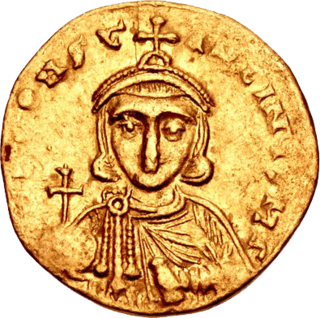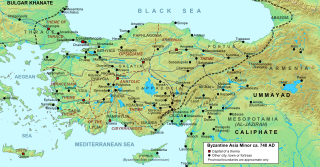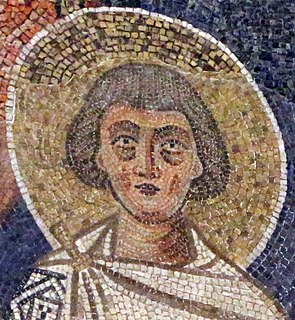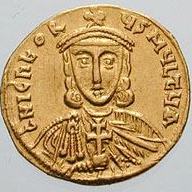| Tiberius Petasius | |||||||||
|---|---|---|---|---|---|---|---|---|---|
| Usurper of the Byzantine Empire | |||||||||
 Solidus minted in Tiberius' name | |||||||||
| Reign | c.730/731 | ||||||||
| Predecessor | Leo III | ||||||||
| Successor | Leo III | ||||||||
| Died | 730/731 | ||||||||
| |||||||||
Tiberius Petasius was a Byzantine usurper in Italy c.730/731.
| Tiberius Petasius | |||||||||
|---|---|---|---|---|---|---|---|---|---|
| Usurper of the Byzantine Empire | |||||||||
 Solidus minted in Tiberius' name | |||||||||
| Reign | c.730/731 | ||||||||
| Predecessor | Leo III | ||||||||
| Successor | Leo III | ||||||||
| Died | 730/731 | ||||||||
| |||||||||
Tiberius Petasius was a Byzantine usurper in Italy c.730/731.
Very little of Tiberius' life is known, other than that he was born Petasius, [1] and that he revolted against the Byzantine Emperor Leo III the Isaurian (r. 717–741) [2] in either 730 or 731, [3] [4] in Tuscia, Italy, [5] [6] taking the regnal name Tiberius. [1] It is possible that he was acclaimed as emperor by local Italian assemblies, who subsequently lost heart when the rebellion of Agallianos Kontoskeles in Greece was crushed. [7] Tiberius gained the allegiance of several towns near Tuscia, including Castrum Manturianense (identified by the historian Ludovico Muratori as modern-day Barbarano Romano), Blera, and Luna (modern-day location unknown, but likely not the Luna in northern Etruria); Tiberius based himself out of Castrum Manturianense. [4]
The Exarch of Ravenna, Eutychius (r. c.727 – 751), was sent to suppress Tiberius' revolt. Eutychius was short on manpower, thus Pope Gregory II (r. 715–731), who did not support Leo III, but opposed the creation of rival emperors, sent several bishops, as well as Papal forces to support Eutychius. [2] [5] [6] Their combined armies marched to Castrum Manturianense, crushed the rebellion in battle, and killed Tiberius. [4] [5] [6] After killing Tiberius, Eutychius sent his head to Leo III. [2]
The issue of Iconoclasm may have played a part in Tiberius' revolt, with Tiberius deriving support from Italians who opposed Leo III's iconoclastic policies, [8] although the only source which states that the anti-Iconoclastic sentiment of the Italians was related to the revolt of Tiberius comes from a much later anti-Iconoclast. [9]

Leo III the Isaurian, also known as the Syrian, was Byzantine Emperor from 717 until his death in 741 and founder of the Isaurian dynasty. He put an end to the Twenty Years' Anarchy, a period of great instability in the Byzantine Empire between 695 and 717, marked by the rapid succession of several emperors to the throne. He also successfully defended the Empire against the invading Umayyads and forbade the veneration of icons.

Pope Gregory II was the bishop of Rome from 19 May 715 to his death. His defiance of Emperor Leo III the Isaurian as a result of the iconoclastic controversy in the Eastern Empire prepared the way for a long series of revolts, schisms and civil wars that eventually led to the establishment of the temporal power of the popes.

Year 730 (DCCXXX) was a common year starting on Sunday of the Julian calendar. The denomination 730 for this year has been used since the early medieval period, when the Anno Domini calendar era became the prevalent method in Europe for naming years.

Philippikos or Philippicus was Byzantine emperor from 711 to 713.

Theodosius III or Theodosios III was Byzantine emperor from c. May 715 to 25 March 717. Before rising to power and seizing the throne of the Byzantine Empire, he was a tax collector in Adramyttium. In 715, the Byzantine navy and the troops of the Opsician Theme revolted against Byzantine Emperor Anastasios II, acclaiming the reluctant Theodosius as Emperor Theodosius III. Theodosius led his troops to Chrysopolis and then Constantinople, the capital, seizing the city in November 715. Anastasios did not surrender until several months later, accepting exile into the monastery in return for safety. Many themes refused to recognize the legitimacy of Theodosius, believing him to be a puppet of the troops of the Opsician Theme, especially the Anatolics and the Armeniacs under their respective strategoi (generals) Leo the Isaurian and Artabasdos.

Artavasdos or Artabasdos, Latinized as Artabasdus, was a Byzantine general of Armenian descent who seized the throne from June 741 or 742 until November 743, in usurpation of the reign of Constantine V.

Leontius or Leontios was Byzantine emperor from 695 to 698. Little is known of his early life, other than that he was born in Isauria in Asia Minor. He was given the title of patrikios, and made strategos of the Anatolic Theme under Emperor Constantine IV. He led forces against the Umayyads during the early years of Justinian II's reign, securing victory and forcing the Umayyad caliph, Abd al-Malik ibn Marwan, to sue for peace.

Tiberius III was Byzantine emperor from 698 to 705 AD. Little is known about his early life, other than that he was droungarios, a mid-level commander, of the Cibyrrhaeots, and that his birth name was Apsimar. In 696, Tiberius was part of an army led by John the Patrician sent by Byzantine Emperor Leontios to retake the city of Carthage in the Exarchate of Africa, which had been captured by the Arab Umayyads. After seizing the city, this army was pushed back by Umayyad reinforcements and retreated to the island of Crete; some of the officers, fearing the wrath of Leontios, killed John and declared Tiberius emperor. Tiberius swiftly gathered a fleet, sailed for Constantinople, and deposed Leontios. Tiberius did not attempt to retake Byzantine Africa from the Umayyads, but campaigned against them along the eastern border with some success. In 705 former Emperor Justinian II, who had been deposed by Leontios, led an army of Slavs and Bulgars to Constantinople, and after entering the city secretly, deposed Tiberius. Tiberius fled to Bithynia, but was captured several months later and beheaded between August 705 and February 706. His body was initially thrown into the sea, but was later recovered and buried in a church on the island of Prote.

Constantine V was Byzantine emperor from 741 to 775. His reign saw a consolidation of Byzantine security from external threats. As an able military leader, Constantine took advantage of civil war in the Muslim world to make limited offensives on the Arab frontier. With this eastern frontier secure, he undertook repeated campaigns against the Bulgars in the Balkans. His military activity, and policy of settling Christian populations from the Arab frontier in Thrace, made Byzantium's hold on its Balkan territories more secure.
Eutychius was the last Exarch of Ravenna, heading the Exarchate from 726 or 727 until 751.
Antony IKassymatas, Ecumenical Patriarch of Constantinople from January 821 to January 837.

The Byzantine Iconoclasm were two periods in the history of the Byzantine Empire when the use of religious images or icons was opposed by religious and imperial authorities within the Orthodox Church and the temporal imperial hierarchy. The First Iconoclasm, as it is sometimes called, occurred between about 726 and 787, while the Second Iconoclasm occurred between 814 and 842. According to the traditional view, Byzantine Iconoclasm was started by a ban on religious images promulgated by the Byzantine Emperor Leo III the Isaurian, and continued under his successors. It was accompanied by widespread destruction of religious images and persecution of supporters of the veneration of images. The Papacy remained firmly in support of the use of religious images throughout the period, and the whole episode widened the growing divergence between the Byzantine and Carolingian traditions in what was still a unified European Church, as well as facilitating the reduction or removal of Byzantine political control over parts of the Italian Peninsula.
The Excubitors were founded in c. 460 as an imperial guard unit by the Byzantine emperor Leo I the Thracian. The 300-strong force, originally recruited from among the warlike mountain tribe of the Isaurians, replaced the older Scholae Palatinae as the main imperial bodyguard. The Excubitors remained an active military unit for the next two centuries, although, as imperial bodyguards, they did not often go on campaign. Their commander, the count of the Excubitors, soon acquired great influence. Justin I was able to use this position to rise to the throne in 518, and henceforth the counts of the Excubitors were among the main political power-holders of their day; two more, Tiberius II Constantine and Maurice, rose to become emperors in the late 6th century.

This history of the Byzantine Empire covers the history of the Eastern Roman Empire from late antiquity until the Fall of Constantinople in 1453 AD. Several events from the 4th to 6th centuries mark the transitional period during which the Roman Empire's east and west divided. In 285, the emperor Diocletian partitioned the Roman Empire's administration into eastern and western halves. Between 324 and 330, Constantine I transferred the main capital from Rome to Byzantium, later known as Constantinople and Nova Roma. Under Theodosius I, Christianity became the Empire's official state religion and others such as Roman polytheism were proscribed. And finally, under the reign of Heraclius, the Empire's military and administration were restructured and adopted Greek for official use instead of Latin. Thus, although it continued the Roman state and maintained Roman state traditions, modern historians distinguish Byzantium from ancient Rome insofar as it was oriented towards Greek rather than Latin culture, and characterised by Orthodox Christianity rather than Roman polytheism.

The Anatolic Theme, more properly known as the Theme of the Anatolics, was a Byzantine theme in central Asia Minor. From its establishment, it was the largest and senior-most of the themes, and its military governors (stratēgoi) were powerful individuals, several of them rising to the imperial throne or launching failed rebellions to capture it. The theme and its army played an important role in the Arab–Byzantine wars of the 7th–10th centuries, after which it enjoyed a period of relative peace that lasted until its conquest by the Seljuk Turks in the late 1070s.

The Opsician Theme or simply Opsikion was a Byzantine theme located in northwestern Asia Minor. Created from the imperial retinue army, the Opsikion was the largest and most prestigious of the early themes, being located closest to Constantinople. Involved in several revolts in the 8th century, it was split in three after ca. 750, and lost its former pre-eminence. It survived as a middle-tier theme until after the Fourth Crusade.
Arsaber, was a Byzantine noble who attempted an unsuccessful usurpation of the Byzantine imperial throne in 808.

Heraclius was Byzantine co-emperor from 659 to 681. He was the son of Emperor Constans II and Fausta, who was elevated in 659, before his father departed for Italy. After the death of Constans, Heraclius' brother Constantine IV ascended the throne as senior emperor. Constantine attempted to have both Heraclius and Tiberius removed as co-emperors. However, this sparked a popular revolt in 681. Constantine ended the revolt by promising to accede to the demands of the rebels, sending them home, but bringing their leaders into Constantinople. Once there, Constantine had them executed, then imprisoned Tiberius and Heraclius and had their noses slit, after which point they disappear from history.

Nikephoros was junior Byzantine Emperor from 741 to 2 November 743. He was crowned after his father, Artabasdos usurped Emperor Constantine V. Constantine seized power again on 2 November 743, and Nikephoros, Artabasdos, and Niketas were blinded and confined in the Chora Church.
Gothograecia was a region in northwestern Asia Minor on the south side of the Sea of Marmara from at least the late 7th century until the mid-10th. It was part of the region of Opsikion in the Roman (Byzantine) Empire. Its inhabitants, the Greek-speaking descendants of a group of Goths, were known as Gothograeci.